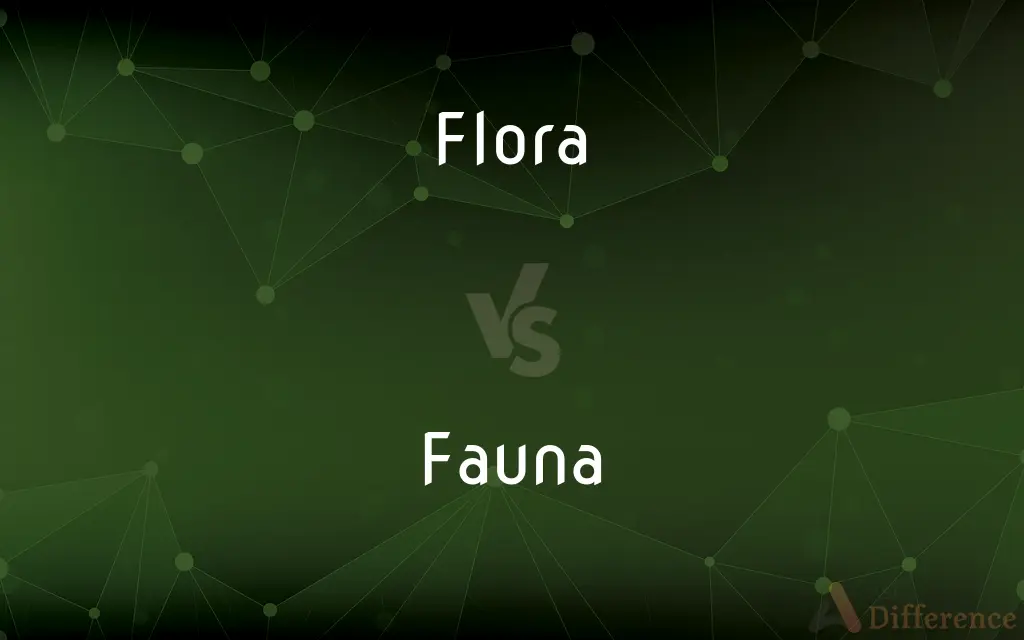Flora vs. Fauna — What's the Difference?
By Tayyaba Rehman — Updated on October 3, 2023
Flora is the plants of a particular region or period. Fauna is the animals of a particular region or period.

Difference Between Flora and Fauna
Table of Contents
ADVERTISEMENT
Key Differences
Flora refers specifically to the plant life found in a specific region, time, environment, or period, emphasizing the diversity and intricacies of vegetation. Fauna, on the other hand, pertains to the animal life in a certain area or during a specific time period, encapsulating the range and behaviors of animals.
When biologists and ecologists study an ecosystem or geographical area, they consider both the Flora and Fauna. While Flora addresses everything from trees, shrubs, and flowers to mosses and fungi, Fauna encompasses mammals, birds, fish, insects, and other animal species. Both contribute to the ecological balance and health of an environment.
It's essential to recognize that both Flora and Fauna play interconnected roles within ecosystems. The Flora in a region can determine the types of Fauna that thrive there. For instance, dense forests may be home to specific species of animals that rely on trees for shelter and food. Conversely, the behaviors and habits of Fauna can influence the distribution and health of Flora. Herbivores, for example, play a role in seed dispersion and plant control.
Over time, both Flora and Fauna can evolve and adapt to environmental changes, human influences, and other factors. This evolution ensures the continued survival of species. However, changes to either Flora or Fauna can have cascading effects on the other, highlighting their interdependence.
Lastly, while Flora and Fauna are scientific terms used to describe plant and animal life respectively, they also hold cultural, historical, and aesthetic significance. Different regions of the world pride themselves on their unique Flora and Fauna, which contribute to regional identities and traditions.
ADVERTISEMENT
Comparison Chart
Refers to
Plant life
Animal life
Includes
Trees, shrubs, flowers, mosses, fungi
Mammals, birds, fish, insects
Role in Ecosystem
Provides food, shelter, and contributes to soil health
Helps in pollination, seed dispersal, etc.
Affected by
Climate, soil quality, water availability
Availability of food, predators, shelter
Cultural significance
Regional plants, traditional medicines
Regional animals, cultural symbols
Compare with Definitions
Flora
Plant life in a particular region
The Flora of the Amazon is incredibly diverse.
Fauna
Animal life in a particular region
Australia's Fauna includes kangaroos and koalas.
Flora
The collective plants in an ecosystem
The forest's Flora provides habitat for countless species.
Fauna
Animal species in a habitat
Tropical rainforest Fauna is known for its colorful birds.
Flora
Botanical organisms in a habitat
Marine Flora includes various types of seaweed.
Fauna
Animals of a specific period
Cretaceous Fauna included the mighty T. rex.
Flora
Plants studied in a specific field
Desert Flora has adapted to survive with little water.
Fauna
Animals studied in a specific field
Mountain Fauna has unique adaptations for high altitudes.
Flora
Flora is all the plant life present in a particular region or time, generally the naturally occurring (indigenous) native plants. The corresponding term for animal life is fauna.
Fauna
The collective animals in an ecosystem
The lake's Fauna thrives due to the clean water.
Flora
The goddess of flowers.
Fauna
Fauna is all of the animal life present in a particular region or time. The corresponding term for plants is flora.
Flora
(used with a sing. or pl. verb) Plants considered as a group, especially the plants of a particular country, region, or time.
Fauna
(used with a sing. or pl. verb) Animals, especially the animals of a particular region or period, considered as a group.
Flora
A treatise describing the plants of a region or time.
Fauna
A catalog of the animals of a specific region or period.
Flora
The bacteria and other microorganisms that normally inhabit a bodily organ or part
Intestinal flora.
Fauna
(uncountable) Animals considered as a group; especially those of a particular country, region, time.
The flora and fauna
Flora
Plants considered as a group, especially those of a particular country, region, time, etc.
Fauna
(countable) A book, cataloguing the animals of a country.
Flora
A book describing the plants of a country, region, time, etc.
Fauna
The animals of any given area or epoch; as, the fauna of America; fossil fauna; recent fauna.
Flora
The microorganisms that inhabit some part of the body.
Fauna
All the animal life in a particular region
Flora
The goddess of flowers and spring.
Fauna
A living organism characterized by voluntary movement
Flora
The complete system of vegetable species growing without cultivation in a given locality, region, or period; a list or description of, or treatise on, such plants.
Flora
All the plant life in a particular region
Flora
A living organism lacking the power of locomotion
Flora
Plants of a specific period
Jurassic Flora differed greatly from today's plants.
Common Curiosities
Can Fauna include marine life?
Yes, Fauna refers to all animal life, including marine species.
How does human activity impact Flora and Fauna?
Human activities can cause habitat destruction, pollution, and climate change, affecting both Flora and Fauna.
How does Fauna help Flora reproduce?
Some Fauna pollinate flowers or disperse seeds, aiding Flora reproduction.
Are Flora and Fauna used in medicine?
Yes, many medicines are derived from plants (Flora) and some animal products (Fauna).
Can Flora influence the climate?
Yes, Flora, especially forests, can influence local climates and global carbon dioxide levels.
Do all areas have the same Fauna?
No, Fauna varies based on factors like geography, climate, and available Flora.
Does Flora only refer to flowers?
No, Flora encompasses all plant life, not just flowers.
How do invasive species affect native Fauna?
Invasive species can outcompete, prey on, or bring diseases to native Fauna.
Why is preserving native Flora and Fauna important?
Native Flora and Fauna maintain ecological balance, cultural identity, and provide potential medical resources.
Is bacteria included in Flora?
While bacteria isn't traditionally termed as Flora, the term "microbial flora" is used to describe communities of microorganisms.
Can Flora evolve?
Yes, like all living organisms, Flora can evolve over time in response to environmental changes.
Share Your Discovery

Previous Comparison
Freezing vs. Icy
Next Comparison
Leftard vs. RightardAuthor Spotlight
Written by
Tayyaba RehmanTayyaba Rehman is a distinguished writer, currently serving as a primary contributor to askdifference.com. As a researcher in semantics and etymology, Tayyaba's passion for the complexity of languages and their distinctions has found a perfect home on the platform. Tayyaba delves into the intricacies of language, distinguishing between commonly confused words and phrases, thereby providing clarity for readers worldwide.














































